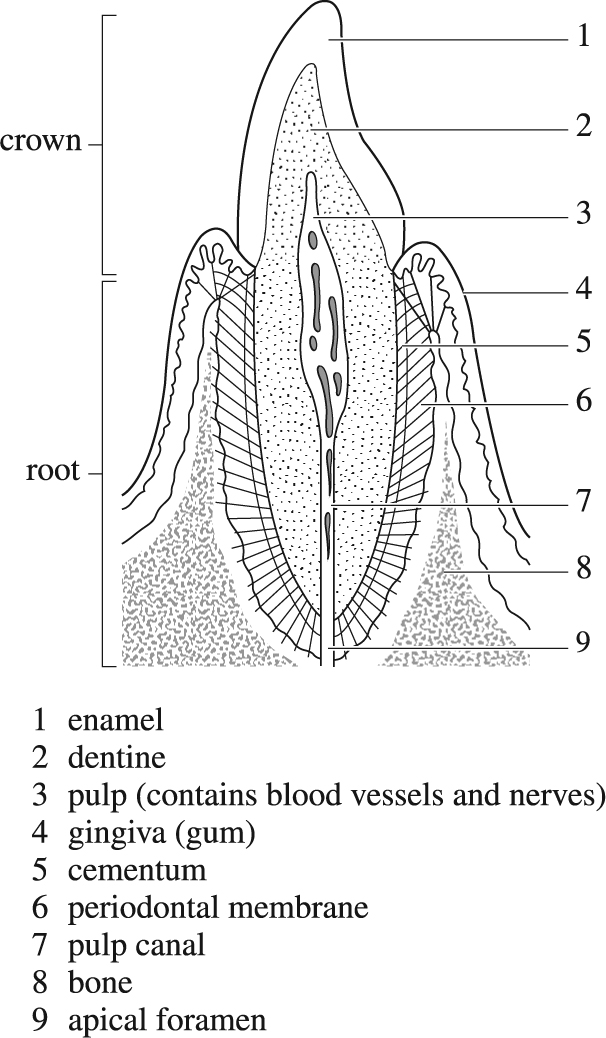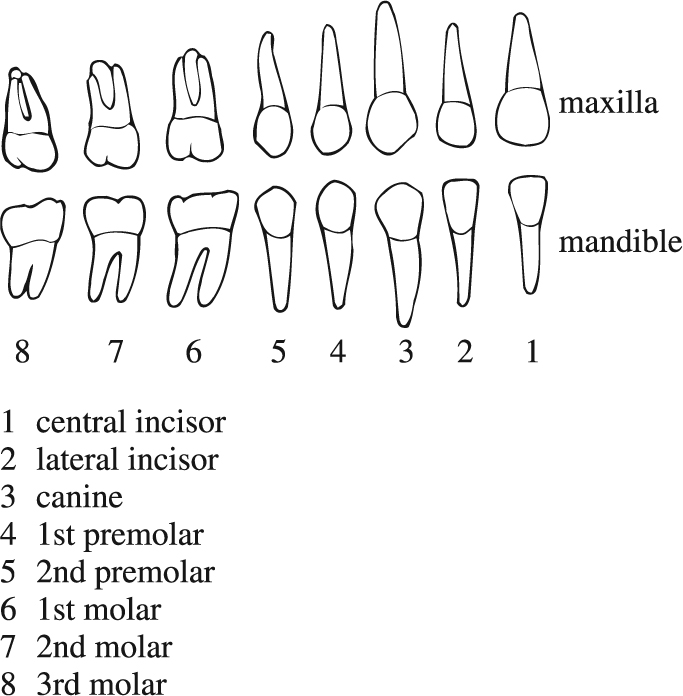Hard organs developed from the mucous membranes of the mouth and embedded in the jawbones, used to bite and grind food and to aid clarity of speech.
Each tooth is composed of enamel, dentine, cement, pulp and periodontal membrane.
is the almost translucent material made of calcified salts which covers the crown of a tooth. It comprises millions of long, six-sided prisms set on end on the dentine (see below), and is thickest over the biting surface of the tooth. With increasing age the teeth may be worn away on the surface, so that the dentine becomes visible. The outer sides of some teeth may be worn away by bad tooth-brushing technique.
is a dense yellowish-white material from which the bulk and the basic shape of a tooth are formed. It is like ivory and is harder than bone but softer than enamel. The crown of the tooth is covered by the hard protective enamel and the root is covered by a bone-like substance called cement. Decay can erode dentine faster than enamel (see TEETH, DISORDERS OF – Caries of the teeth).
or cementum is a thin bone-like material which covers the roots of teeth and helps hold them in the bone. Fibres of the periodontal membrane (see below) are embedded in the cement and the bone. When the gums recede, part of the cement may be exposed and the cells die. Once this has happened, the periodontal membrane can no longer be attached to the tooth and, if sufficient cement is destroyed, the tooth-support will be so weakened that the tooth will become loose.
This is the inner core of the tooth and is composed of a highly vascular, delicate fibrous tissue with many fine nerve-fibres. The pulp is very sensitive to temperature variation and to touch. If the pulp becomes exposed it is likely to become infected with the result that root-canal treatment or extraction of the tooth may be necessary.
A layer of fibrous tissue arranged in groups of fibres which surround and support the root of a tooth in its bone socket. The fibres are interspersed with blood vessels and nerves. Loss of the membrane leads to loss of the tooth. The membrane can release and re-attach the fibres to allow the tooth to move when it erupts, or (to correct dental deformities) is being moved by orthodontic springs.
Most mammals have two sets: a temporary or milk set, followed by a permanent or adult set. Humans have four different categories: incisors, canines (eye-teeth), premolars (bicuspids), and molars. The incisors are chisel-shaped and the canine is pointed. Premolars have two cusps on the crown (one medial to the other) and molars have at least four cusps. They are arranged together in an arch in each jaw and the cusps of opposing teeth interdigitate, that is fit into each other's surface. Children have two incisors, one canine and two molars (total teeth 20) in each quadrant of the mouth; in the adult there are two incisors, one canine, two premolars and three molars (total 32). The crown of the tooth has mesial and distal surfaces which touch the tooth next to it. The mesial surface is the one nearer to the centre line and the distal is the further away. The biting surface is called the incisal edge for the anterior teeth and the occlusal surface for the posterior.

Vertical section through incisor tooth.

The permanent teeth of the left side of upper and lower jaws.
Eruption of teeth is in a definite order and at a fixed time, although there may be a few months’ leeway in either direction. Excessive delay is found in some disorders such as congenital HYPOTHYROIDISM. It may also be associated with local abnormalities of the jaws such as cysts, malformed teeth and supernumerary teeth.
The usual order of eruption of deciduous teeth is:
Middle incisors | 6–8 months |
Lateral incisors | 8–10 months |
First molars | 12–16 months |
Canines (eye-teeth) | 16–20 months |
Second molars | 20–30 months |
The usual order of eruption of permanent teeth is:
First molars | 6–7 years |
Middle incisors | 6–8 years |
Lateral incisors | 7–9 years |
Canines | 9–12 years |
First and second premolars | 10–12 years |
Second molars | 11–13 years |
Third molars (wisdom teeth) | 17–21 years |